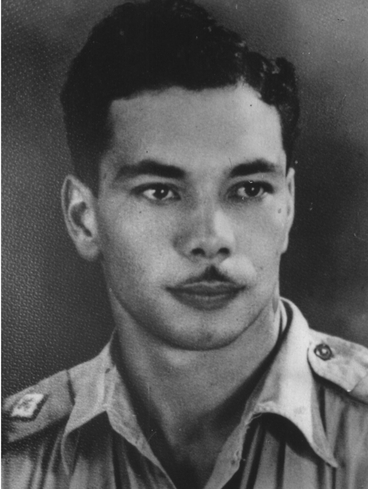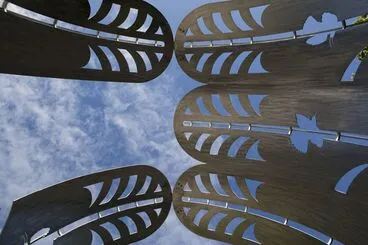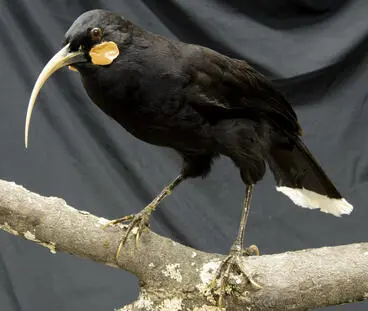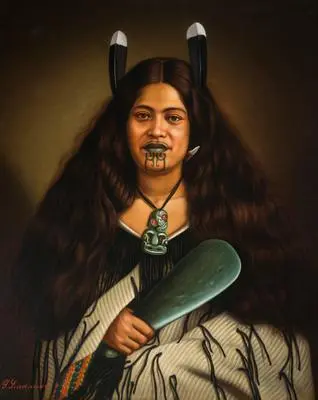Huia: Tuia Mātauranga Curiosity Card
A DigitalNZ Story by National Library Services to Schools
Specimen of the extinct huia bird (Heteralocha acutirostris).
Huia, Heteralocha acutirostris
Museum of New Zealand Te Papa Tongarewa
WHAKATAUKĪ
"He huia tangata tahi."
"There is but one person synonymous with the huia, the chief."
Three huia (Heteralocha acutirostris)
Museum of New Zealand Te Papa Tongarewa
Huia. Heteralocha acutirostris. From the series: Extinct Birds of New Zealand.
Museum of New Zealand Te Papa Tongarewa
Huia
Museum of New Zealand Te Papa Tongarewa
BACKGROUND
Huia - extinction
The huia (Heteralocha acutirostris) has long had iconic significance in New Zealand because of its beauty. The white-tipped tail feathers were a revered taonga (treasure) for Māori at the time of European arrival. Because the female huia had a downward pointing beak that was much larger than that of the male, pairs of huia were often killed and preserved in glass cases.
Huia were easy to catch. There was a rapid decline in their numbers in the late 19th century, probably because of a combination of bush clearance, predation and hunting. Legislation to stop the birds being hunted was passed in 1892, but it was too late to avoid their extinction, which happened in the early 20th century.
'Extinctions - Smaller birds, reptiles, frogs, fish, plants', URL: http://www.teara.govt.nz/en/photograph/13671/huia, (Ministry for Culture and Heritage), (published 24-September-2007)
Symbols of status
In traditional Māori thought, many birds were seen as chiefly. The feathers of certain birds were used as adornment for high-born people – particularly plumes worn in the hair. Chiefs wore the kahu huruhuru (feather cloak), made from the feathers of the most beautiful birds.
Huia
The huia, extinct since the early 20th century, had black tail feathers with white tips, which high-ranking people wore in their hair. The group of 12 feathers from a huia’s tail, usually still joined at the base, was called a mareko, and was worn by high chiefs going into battle. Huia feathers were kept in a carved wooden chest called a waka huia.
The male huia had a straight beak, while the female’s was curved. One story explains its origin. A chief found a female huia in a trap, and plucked two tail feathers as plumes. He enchanted the bird so she would return when he needed more plumes. One time she arrived with feathers ruffled from sitting on her nest. Annoyed, the chief gave her a long, curved beak so she could reach her tail feathers and lift them out of the way.
Source: 'Ngā manu – birds - Symbols of status', URL: http://www.teara.govt.nz/en/nga-manu-birds, (Ministry for Culture and Heritage), (updated 17-February-2015)
He tohu rangatira
E ai ki te Māori ko ētahi manu ka tohu ki te rangatiratanga. Ko ngā huruhuru o ētahi manu hei whakarākai i te māhunga o te ariki, o te rangatira. Kākahungia ai te rangatira ki ngā kākahu ka whatua i ngā huruhuru o ngā manu ātaahua rawa atu.
Huia
Nō te tīmatanga o te rau tau atu i 1900 ka mate ā-moa tēnei manu ātaahua te huia. He pango ōna kura, he tea te pito. Koinei ngā tohu ka mau i te tātai ariki. Karangatia ai ngā kōtore e 12 o te huia he mareko, whakamau ai e te rangatira ēnei hei rākai mō tōna māhunga i mua i te kuhu atu ki te pakanga. Whakanōhia ai ngā kura o tēnei manu ki roto i tōna waka huia.
He motuhenga ngā ngutu o te tama, he piko ō te karawa. Anei te pūrākau whakamārama: ka taka ki tētahi rā, ka hura e tētahi rangatira te karawa huia kua mau i roto i tētahi māhanga. Ka hūtia e te rangatira rā ngā kōtore huia e rua, kātahi ka karakiatia e ia taua manu kia taea ai tana hoki ki te huhuti anō i ōna huruhuru. Tērā te wā ka haere ake te manu rā, kua puhirua katoa ōna huruhuru nā te noho ki runga kōhanga. Nā tana kaha riri ki tēnei, ka takahiria e te rangatira rā ngā ngutu o te karawa huia kia roa kia tarea ai e ia te whakatika tōna hikumārō ki te taha.
Source: 'Ngā manu - He tohu rangatira', URL: http://www.teara.govt.nz/mi/nga-manu, (Ministry for Culture and Heritage), (updated 17-February-2015)
Hunted to extinction
Before the arrival of Europeans, the huia (Heteralocha acutirostris) was already a rare bird, confined to the mountain ranges of the lower North Island. Its blue-black plumage was similar to the tūī’s, but the white-banded tail feathers were unique among endemic birds and were prized by Māori. A European craze for huia feathers led to increased hunting, and by the 1920s this beautiful bird was extinct. Hunting hastened the demise of a species that was already declining as a result of habitat loss and predation by rats, cats and stoats.
Source: 'Natural environment - Fauna', URL: http://www.teara.govt.nz/en/photograph/2687/hunted-to-extinction, (Ministry for Culture and Heritage), (undated)
Mate ā-moa
I te taenga o te Pākehā ki Aotearoa, i te mōrearea te noho a te huia (Heteralocha acutirostris), e toe ana ki ngā ika whenua i te tonga o Te Ika-a-Māui anake. He rite ōna huruhuru ki ngā huruhuru pango-kikorangi o te tūī, engari anō te kōtore o te huia, i manakotia nuitia e te Māori. Nāwai ā, ka hiahia te iwi Pākehā ki ngā huruhuru o tēnei manu; whāia, kia tae ki te tekau tau atu i 1920 kua ngaro ā-moa te huia. I tua atu i te tangata me āna mahi, kainga ai te huia e te kiore, te ngeru me te toriura.
Source: 'Te ao tūroa - Ngā kararehe, ngā manu', URL: http://www.teara.govt.nz/mi/photograph/2687/mate-a-moa, (Ministry for Culture and Heritage), (undated)
Waka huia
Manatū Taonga, the Ministry for Culture and Heritage
Huia brooch
Manatū Taonga, the Ministry for Culture and Heritage
Huia feather
Museum of New Zealand Te Papa Tongarewa
Nga Huia
Te Whare o Rehua Sarjeant Gallery
Taylor, Richard, 1805-1873 :Takari, a Pukehika chief. [ca 1848].
Alexander Turnbull Library
Huia-feather headdresses
Manatū Taonga, the Ministry for Culture and Heritage
QUICK FACTS
- The last huia were sighted early last century.
- The tail feathers of huia were often worn by people of rank.
- Waka huia (treasure box) were designed to hold prized huia feathers and also other taonga or treasures.
- A biological feature of huia was the difference between the males and females in the size and shape of their beaks.
- Huia were about the size of an Australian magpie.
Maori woman wearing korowai and huia feathers
Alexander Turnbull Library
Hamiora Tu. Chief of Ngaiterangi
Auckland War Memorial Museum Tāmaki Paenga Hira
Duke and Duchess of York with huia feathers in their hats after a reception
Alexander Turnbull Library
Maori child, Te Ore Ore
Wairarapa Archive
Mutu Brandon and Miriama Te Rangirunga - Photograph taken by William Henry Thomas Partington
Alexander Turnbull Library
OTHER RESOURCES
Conservation comment: What became of the huia? — he pitopito kōrero nā Mike Dickison i tuhi.
Huia, the sacred bird — an article that investigates the importance and extinction of the huia.
NZ Birds - Huia — ko tēnei te pae tukutuku o NZ Birds.
Sound archives - the huia — eye witness descriptions and a re-creation of the bird's call.
The Call of the Huia — the story of the Huia is a cautionary tale. A documentary narrated by Dame Anne Salmond.
The far-famed huia believed to be extinct — a 1926 newspaper article reports that it is generally believed that the huia is now extinct.
The huia — the story of the huia weaves the strands of biology, history, conservation, arts and culture.
The iconic huia — information about the huia from New Zealand Birds Online.
Who killed the huia? — sadly you'll never get to see a live huia — they mysteriously died out, a hundred years ago. But how?
["Huia" Schooner]
Auckland War Memorial Museum Tāmaki Paenga Hira
Aubrey Huia Balzer
Manatū Taonga, the Ministry for Culture and Heritage
Huia cigarette tobacco tin
Manatū Taonga, the Ministry for Culture and Heritage
[New Zealand Government Tourist Department] :Maori chief. New Zealand [1930-1940s]
Alexander Turnbull Library
Nga Huruhuru Rangatira public sculpture (detail)
Palmerston North City Library
FERTILE QUESTIONS
- What impact does the extinction of a species have?
- How and why do we value some animals more than others?
- He aha i whakahirahira ake ai te whai torōwhe i te oranga tonutanga o tētahi momo?
- Why is human desire more important than nature?
- He aha ngā akoranga a te tangata i te matenga a-moa o ngā momo kararehe?
- What is your question?
Huia, Heteralocha acutirostris
Museum of New Zealand Te Papa Tongarewa
Huia, Heteralocha acutirostris
Museum of New Zealand Te Papa Tongarewa
Huia
Puke Ariki
ADDITIONAL QUESTIONS
- Why do we try to save some animals/species and not others?
- Are people more important than animals?
Miria Simpson with painting of Pare Watene
Alexander Turnbull Library
Pare Watene
Auckland Art Gallery Toi o Tāmaki
This story was curated and compiled by Te Puna Mātauranga o Aotearoa | National Library of New Zealand, Services to Schools staff, 2019.


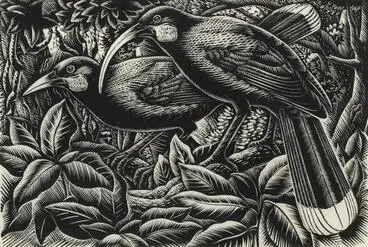

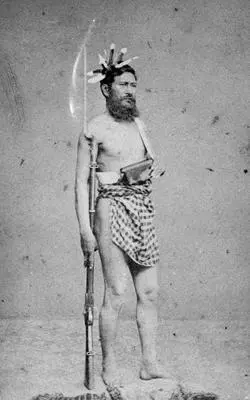
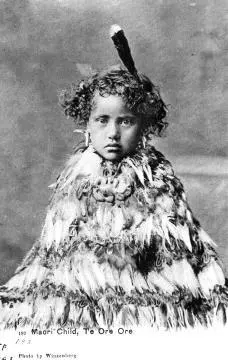
![["Huia" Schooner] Image: ["Huia" Schooner]](https://thumbnailer.digitalnz.org/?resize=770x&src=https%3A%2F%2Fcollection-api.aucklandmuseum.com%2Frecords%2Fimages%2Fmedium%2F576510%2F654d2bb2b246d6385e62e8c4e3d20a8ff5e7b026.jpg&resize=368%253E)
